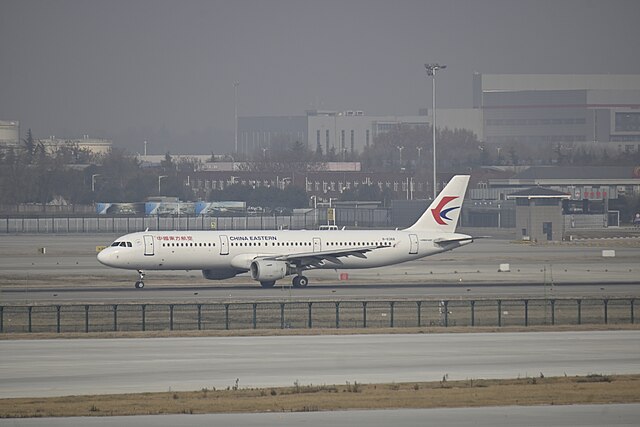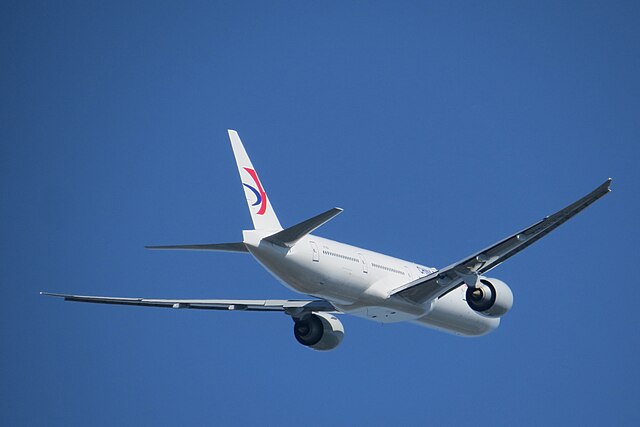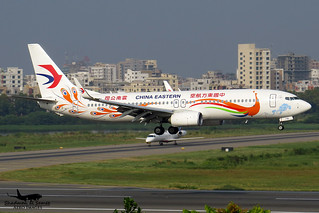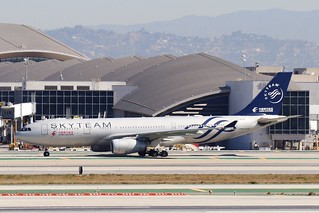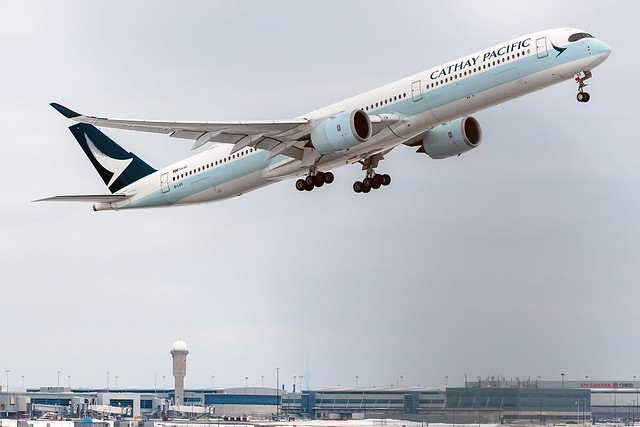China Eastern A321 at Hong Kong on May 24th 2017, runway excursion on landing
Last Update: September 8, 2022 / 17:43:09 GMT/Zulu time
Incident Facts
Date of incident
May 24, 2017
Classification
Incident
Airline
China Eastern Airlines
Flight number
MU-765
Departure
Nanjing, China
Destination
Hong Kong, China
Aircraft Registration
B-6366
Aircraft Type
Airbus A321
ICAO Type Designator
A321
Airport ICAO Code
VHHH
The runway needed to be closed for about two hours until the aircraft was removed from the runway.
Weather services in Hong Kong had issued weather warnings suggesting up to 70mm of rain could fall within an hour. Up to that time about 20-30mm rain had been recorded.
On Jun 24th 2017 Hong Kong's CAD reported the captain (ATPL, 5,992 hours total, 5,740 hours on type) was pilot flying. The aircraft had performed an ILS approach to runway 25R, touched down and was cleared to vacate via taxiway A4. When the aircraft was abeam taxiway A3 the aircraft began to veer right and came to a stop with the nose gear and right hand main gear off the right hand edge of the paved surface of the runway. There were no injuries and no structural damage.
On Sep 8th 2022 Hong Kong's CAD released their final report concluding the probable causes of the serious incident were:
The flight crew considered that the runway was dry and selected the inappropriate autobrake mode before landing. Their subsequent aircraft speed control after the aircraft missed RET A6 was also ineffective to decelerate the aircraft to a speed appropriate for vacating the runway via RET A5 or RET A4.
At the last stage of the rollout, the weathercock effect created by the lateral wind turned the aircraft to the right and the directional control by differential braking was not effective on the runway section which was contaminated with water and with friction values probably below the limit.
Contributing Factors
The aircraft landed long and touched down at a distance 764 ft beyond the 1 500 ft aiming point marking, resulting in reduced time and distance to decelerate.
After the deceleration rate was found unsatisfactory upon point B, the flight crew did not make the best use of manual braking and reverse thrust to slow the aircraft down to the desired speed.
The aircraft suffered viscous hydroplaning between point B and point G of the rollout, which resulted in poor braking action and reduced aircraft deceleration rate.
The CAD analysed:
The crew had already experienced a go around at decision altitude from RWY 07L due to heavy rain and poor visibility, they were radar vectored for a further approach during which time the landing runway was changed to the reciprocal RWY 25R. Although no NOTAM was issued prior to the incident notifying that the runway might be liable to be slippery when wet, ATIS ‘B’ and ‘C’ and SPECI VHHH issued at 1041 hrs indicated that RWY 25R was wet and would be subject to thunderstorm with heavy rain. The runway and weather conditions would have been apparent to the crew. Such information should be taken into account by the flight crew in the estimation of the landing distance.
In the morning of the day of incident, Hong Kong including the airport was affected by heavy or very heavy rain and thunderstorms. From 0915 hrs to 1130 hrs, the Red Rainstorm signal was issued by the HKO. It indicated that within this period heavy rain had fallen or was expected to fall generally over Hong Kong, exceeding 50 mm in an hour, and was likely to continue. It was highly probable that at least part of the surface of RWY 25R covered by the rollout of the aircraft was contaminated with water.
Starting from around 1006 hrs of the day, six arrival flights, including CES765, went around from RWY 07L due to windshear, fluctuating wind conditions and rain caused by a thunderstorm in the vicinity of HKIA. All flight crew of these arrival flights would have known the prevailing weather conditions at HKIA and that the runway surface was wet.
The incident aircraft landed with a crosswind from the right. Crosswinds may prevent adequate runway drainage of water, causing pooling. A runway surface with a coarse matrix or grooves takes longer time for water to build up to limiting depths, particularly in windy conditions. Under zero wind conditions most runways have adequate crossfall to provide good drainage under quite high rates of precipitation. However, drainage can be seriously affected in wind of about 10 kt or above. A crosswind blowing up the transverse slope of a runway could have a significant effect on water depth. This could lead to hydroplaning on that side and hence asymmetric braking action.
The aircraft landed on the runway centreline at a point about 2 264 ft beyond the RWY 25R threshold, i.e. 764 ft beyond the normal touchdown target area of 1 000 ft to 1 500 ft from the threshold. Consequently, the aircraft had less runway distance to decelerate and was closer to the touchdown zone of the opposite runway which was commonly known to have more rubber deposits.
The aircraft touched down at 10:49:47 hrs at an airspeed of 148 kt. During
de-rotation onto the nose wheel, the thrust levers were first brought to IDLE and then maximum reverser thrust. The ground spoilers extended automatically and the LO autobrake mode was activated. The aircraft heading was maintained on the runway with rudder inputs and the ground speed decreased to 90 kt at 10:50:06 hrs when the aircraft was at point B in a duration of 19 seconds. The average longitudinal deceleration was about 0.16 G which was close to the target deceleration rate (0.17 G).
At 10:50:06 hrs, the aircraft was at a ground speed of 90 kt at point B, the PF pressed on the brake pedals and this action disengaged the autobrake. The aircraft at this stage was still under normal braking with antiskid.
The deceleration was around 0.2 G with a peak of 0.28 G in the following 10 seconds. At about point C, the deceleration then decreased to about 0.02 G when no brake pedal input was noted during the next four seconds (from 10:50:18 hrs to 10:50:22 hrs, from point D to point E). Brake pedal inputs were then noted at 10:50:21 hrs with a progressive increase to maximum at 10:50:30 hrs. However, the deceleration remained at around 0.05 G. It was highly probable that the aircraft was experiencing viscous hydroplaning. The aircraft heading was still maintained at around 253 degrees with rudder inputs. The ground speed decreased from 90 kt to 42 kt at 10:50:36 hrs at point F with both thrust levers put to FWD IDLE.
At 10:50:17 hrs the PF moved both thrust levers to FWD IDLE at 70 kt in accordance with the FCOM. However, at this moment the aircraft was just short of point D which was near the entrance of TWY A5, only 3 575 ft from the threshold of the opposite runway. Since the braking action was not effective, appropriate reverse thrust as a means of stopping should have been held until the landing rollout could be contained comfortably within the distance available, but both thrust levers were left at the FWD IDLE position until the aircraft rolled past point F.
At 10:50:36 hrs, the aircraft decelerated to 42 kt at point F near the entrance of TWY A4. This location was within the section of runway, identified as Chainage 300 to 700 for runway friction measurement and rubber removal purposes (see Figure 11), and with average friction values below the limit then published in AIP HK. At this point, the flight crew turned off the antiskid.
The figure above revealed that the brake pressure followed the pedal inputs until about 10:50:30 hrs. From this point on, the brake pressure remained low even though full brake pedal inputs were made. This indicated that the antiskid system was operating by reducing brake pressure to prevent the wheels from locking, which implied that the runway was contaminated with water. The runway section travelled by the aircraft between 10:50:31 hrs and 10:50:38 hrs pretty much aligned with the Chainage range with below average runway friction values.
At 10:50:36 hrs, the aircraft was at point F. As the required deceleration rate was not achieved, the flight crew applied the Loss of Braking procedures in the QRH to set the A/SKID & N/W STRG switch to OFF.
The aircraft heading increased from 254 degrees and the deceleration was about 0.05 G only.
When the antiskid was selected to OFF, Nose Wheel Steering control and hence directional control could only be effected by differential braking.
The maximum braking pressure was also limited to 1 000 psi, which was 1 537 psi less than that in the normal manual braking mode.
According to the flight data, there was no malfunction of the hydraulic system, brake system or the antiskid system. The application of the Loss of Braking procedures limited the use of maximum brake pressure, and cancelled the directional control with the tillers and aircraft wheel lockup protection with the antiskid system.
Although the flight crew applied the Loss of Braking procedures and pressed on the brake pedals, they did not apply MAX reverse thrust which was the first step of the Loss of Braking procedures. According to the FCOM, if needed, flight crew can use maximum reverse thrust until the aircraft comes to a complete stop.
The aircraft was then in a situation of decelerating by manual brake pedal inputs with limited brake pressure and without antiskid on a section of runway with below average friction values.
Starting from about 10:50:36 hrs, the aircraft heading continued to increase towards 268 degrees despite full left brake pedal inputs. The FDR data showed that differential braking was applied with maximum left pedal inputs which resulted in maximum rudder deflection. At the same time, it was noted that both No. 1 and No. 2 wheel speeds dropped from 40 kt to 0 kt while No. 3 and 4 wheel speeds were around 40 kt. This means that the left MLG wheels were locked and skidding occurred after differential braking to the left was applied. The aircraft still continued its deviation to the right. The deceleration did not improve and was still at about 0.05 G with ground speed at about 40 kt.
Between 10:50:43 hrs and 10:50:45 hrs, the left-hand engine thrust lever was momentarily moved to the full forward throttle position and then retarded to the IDLE position. The right-hand engine thrust lever was then moved to half of the forward thrust position and was retarded to the IDLE position. By doing so, the flight crew was probably in an attempt to realign the nose of the aircraft with the centreline of the runway. However, no appreciable effect on the aircraft heading was noted.
Between 10:50:46 hrs and 10:50:55 hrs, the aircraft heading changed to 254 degrees with the deceleration increased to about 0.3 G with a transient up to 0.45 G, probably because the aircraft exited the runway and rolled on the grass verge. The aircraft eventually stopped on the right side of the runway in the touchdown zone of RWY 07L.
Since the aircraft landed with a crosswind from the right, a weathercock effect might be induced resulting in the aircraft turning to the right despite differential braking to the left was applied. It was highly probable that the lateral deviation to the right was a consequence of the weathercock effect combined with water contamination at the runway portions between Chainage 301 to 700 and friction values probably below the limit.
Metars:
VHHH 240400Z 14008KT 110V170 3600 VCTS +SHRA FEW010CB SCT025 24/23 Q1008 RERA TEMPO 1400 TSRA SHRA FEW010CB SCT020=
VHHH 240330Z 16008KT 110V170 2400 1000W R07R/P2000D R25L/P2000D R07L/P2000N R25R/P2000U VCTS +SHRA FEW010CB SCT025 24/23 Q1008 TEMPO 27022G32KT 1400 TSRA SHRA FEW010CB SCT020=
VHHH 240313Z 04009KT 020V090 1900 +TSRA +SHRA FEW010CB SCT025 24/23 Q1008 TEMPO 27022G32KT 1400 TSRA SHRA FEW010CB SCT020=
VHHH 240300Z 01012KT 2100 1400W R07R/P2000D R25L/P2000D R07L/1900D R25R/P2000D VCTS +SHRA FEW010CB SCT025 25/23 Q1008 TEMPO 27022G32KT 1400 TSRA SHRA FEW010CB SCT020=
VHHH 240241Z 35015KT 320V030 3300 R07R/P2000U R25L/1300U R07L/P2000U R25R/1700U +TSRA +SHRA FEW010CB SCT025 25/23 Q1008 TEMPO 1600 TSRA SHRA FEW010CB SCT020=
VHHH 240235Z 35021G33KT 0650 0500E R07R/1900U R25L/1200D R07L/1400U R25R/1100N +TSRA +SHRA FEW010CB SCT025 25/23 Q1008 TEMPO 1600 TSRA SHRA FEW010CB SCT020=
VHHH 240230Z 35023G33KT 0900 0550N R07R/1700N R25L/1500D R07L/1300N R25R/1200N +TSRA +SHRA FEW010CB SCT025 25/24 Q1007 TEMPO 1600 TSRA SHRA FEW010CB SCT020=
VHHH 240229Z 35022G33KT 1200 0900E R07R/2000U R25L/1500D R07L/1400U R25R/1200N +TSRA +SHRA FEW010CB SCT025 25/24 Q1007 TEMPO 1600 TSRA SHRA FEW010CB SCT020=
VHHH 240212Z 31013KT 280V340 1200 0600E R07R/P2000D R25L/P2000D R07L/1500D R25R/1400D +TSRA +SHRA FEW010CB SCT025 25/25 Q1007 TEMPO 1600 TSRA SHRA FEW010CB SCT020=
VHHH 240200Z 33011KT 300V360 1700 1400E R07R/P2000N R25L/P2000D R07L/1800N R25R/1600N +TSRA +SHRA FEW010CB SCT025 26/25 Q1007 WS R07R TEMPO 2000 TSRA SHRA FEW010CB SCT020=
VHHH 240130Z VRB06G17KT 2100 +TSRA FEW010CB SCT025 26/25 Q1007 TEMPO 2000 TSRA SHRA FEW010CB SCT020=
VHHH 240120Z 36012KT 320V020 1400 1300S R07R/P2000D R25L/1700N R07L/1700D R25R/1700N +TSRA FEW010CB SCT025 26/25 Q1007 TEMPO 2000 TSRA SHRA FEW010CB SCT020=
VHHH 240111Z 02013KT 2300 +TSRA FEW010CB SCT025 26/25 Q1007 TEMPO 2500 TSRA SHRA FEW010CB SCT020=
VHHH 240104Z VRB05KT 2600 VCTS SHRA FEW010CB SCT025 26/25 Q1007 TEMPO 2500 TSRA SHRA FEW010CB SCT020=
VHHH 240100Z VRB04KT 4600 VCTS SHRA FEW010CB SCT025 26/25 Q1007 TEMPO 2500 TSRA SHRA FEW010CB SCT020=
VHHH 240052Z 33006KT 280V030 4900 SHRA FEW010CB SCT025 26/25 Q1007 RETS RERA TEMPO 3000 -TSRA SHRA FEW010CB SCT020=
VHHH 240030Z 03011KT 2200 +TSRA FEW010CB SCT025 26/25 Q1006 TEMPO 3000 -TSRA SHRA FEW010CB SCT020=
VHHH 240002Z 08010KT 060V130 3700 +TSRA FEW010CB SCT025 26/25 Q1006 TEMPO 3000 -TSRA SHRA FEW010CB SCT020=
VHHH 240000Z 08010KT 060V130 2900 +SHRA FEW010CB SCT025 26/25 Q1006 TEMPO 3000 -TSRA SHRA FEW010CB SCT020=
VHHH 232344Z 36009KT 320V030 1400 0900E R07R/2000U R25L/2000D R07L/1500U R25R/P2000D +TSRA FEW008CB SCT028 26/25 Q1006 TEMPO 3000 -TSRA SHRA FEW010CB SCT020=
VHHH 232342Z 36009KT 320V030 1700 1200S R07R/1900U R25L/P2000D R07L/1400N R25R/P2000D VCTS +SHRA FEW008CB SCT028 26/25 Q1006 TEMPO 3000 -TSRA SHRA FEW010CB SCT020=
VHHH 232330Z 01006KT 2100 +SHRA FEW008CB SCT028 26/26 Q1006 RETS TEMPO 3000 -TSRA SHRA FEW010CB SCT020=
VHHH 232300Z 07005KT 030V100 2200 +TSRA FEW008CB SCT028 26/26 Q1006 TEMPO 2000 TSRA SHRA FEW010CB SCT020=
VHHH 232255Z 06005KT 030V090 1700 1200N R07R/P2000U R25L/P2000D R07L/2000D R25R/P2000U +TSRA FEW008CB SCT028 26/26 Q1006 TEMPO 3000 -TSRA SHRA FEW010CB SCT020=
VHHH 232239Z 06009KT 2800 1100E R07R/P2000N R25L/P2000D R07L/P2000N R25R/P2000D VCTS SHRA FEW010CB SCT028 26/26 Q1005 TEMPO 3000 -TSRA SHRA FEW010CB SCT020=
VHHH 232230Z 06008KT 3400 TSRA FEW010CB SCT028 27/26 Q1005 TEMPO 3000 -TSRA SHRA FEW010CB SCT020=
VHHH 232220Z 05009KT 3400 TSRA FEW010CB SCT028 27/26 Q1005 TEMPO 3000 -TSRA SHRA FEW010CB SCT020=
VHHH 232209Z 04007KT 4400 SHRA FEW010CB SCT028 27/26 Q1005 TEMPO 3000 -TSRA SHRA FEW010CB SCT020=
VHHH 232200Z 04007KT 5000 SHRA FEW010CB SCT028 28/25 Q1005 TEMPO 3000 -TSRA SHRA FEW010CB SCT020=
Incident Facts
Date of incident
May 24, 2017
Classification
Incident
Airline
China Eastern Airlines
Flight number
MU-765
Departure
Nanjing, China
Destination
Hong Kong, China
Aircraft Registration
B-6366
Aircraft Type
Airbus A321
ICAO Type Designator
A321
Airport ICAO Code
VHHH
This article is published under license from Avherald.com. © of text by Avherald.com.
Article source
You can read 2 more free articles without a subscription.
Subscribe now and continue reading without any limits!
Read unlimited articles and receive our daily update briefing. Gain better insights into what is happening in commercial aviation safety.
Send tip
Support AeroInside by sending a small tip amount.
Related articles
China Eastern A321 at Wuxi on Oct 2nd 2025, bird strike
A China Eastern Airlines Airbus A321-200, registration B-6368 performing flight MU-2701 from Wuxi to Qingdao (China), was climbing out of Wuxi's…
China Eastern B773 at Singapore on Aug 28th 2024, runway incursion
A China Eastern Boeing 777-300, registration B-2021 performing flight MU-565 from Shanghai Pudong (China) to Singapore (Singapore) with 220 people on…
China Eastern B738 near Guangzhou on Mar 21st 2022, lost altitude and impacted terrain
A China Eastern Boeing 737-800, registration B-1791 performing flight MU-5735 from Kunming to Guangzhou (China) with 123 passengers and 9 crew on…
China Eastern A332 at Shanghai on Dec 9th 2023, could not retract landing gear
A China Eastern Airbus A330-200, registration B-6538 performing flight MU-533 from Shanghai Pudong (China) to London Heathrow,EN (UK), was climbing…
China Eastern A333 near Xiamen on Dec 3rd 2023, uncontained engine failure
A China Eastern Airbus A330-300, registration B-8970 performing flight MU-721 from Shanghai Hongquiao to Hong Kong (China), was enroute at 10400…
Newest articles
Endeavor CRJ7 at Charlotte on Dec 22nd 2025, engine shut down in flight
An Endeavor Canadair CRJ-700 on behalf of Delta Airlines, registration N641CA performing flight DL-4827 from Charlotte,NC to Atlanta,GA (USA) with 68…
Cathay Pacific A35K at Hong Kong on Nov 26th 2025, tail strike during go around
A Cathay Pacific Airbus A350-1000, registration B-LXO performing flight CX-764 from Ho Chi Minh City (Vietnam) to Hong Kong (China), was landing on…
Subscribe today
Are you researching aviation incidents? Get access to AeroInside Insights, unlimited read access and receive the daily newsletter.
Pick your plan and subscribePartner

ELITE Simulation Solutions is a leading global provider of Flight Simulation Training Devices, IFR training software as well as flight controls and related services. Find out more.
SafetyScan Pro provides streamlined access to thousands of aviation accident reports. Tailored for your safety management efforts. Book your demo today
AeroInside Blog
Popular aircraft
Airbus A320Boeing 737-800
Boeing 737-800 MAX
Popular airlines
American AirlinesUnited
Delta
Air Canada
Lufthansa
British Airways




